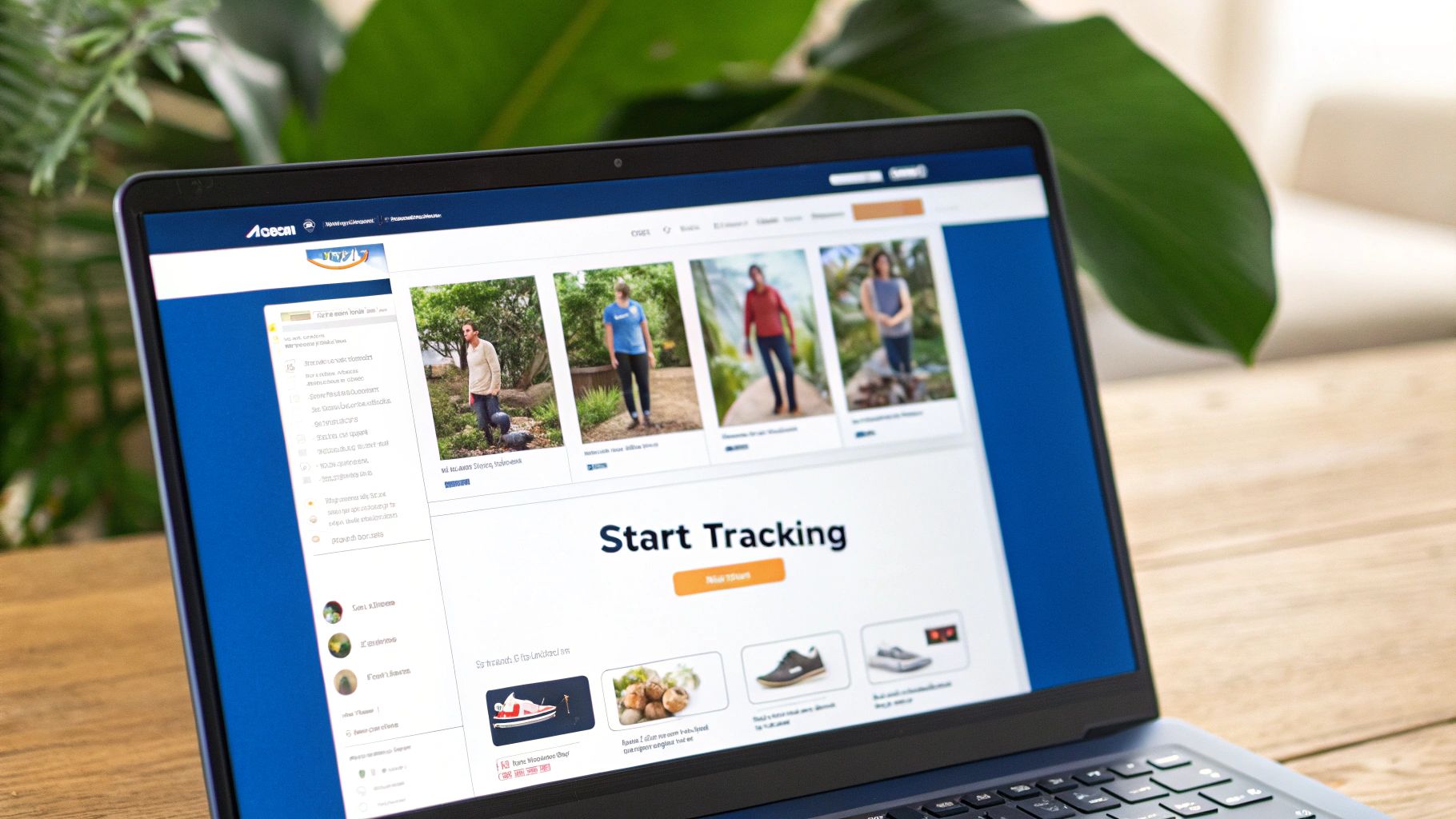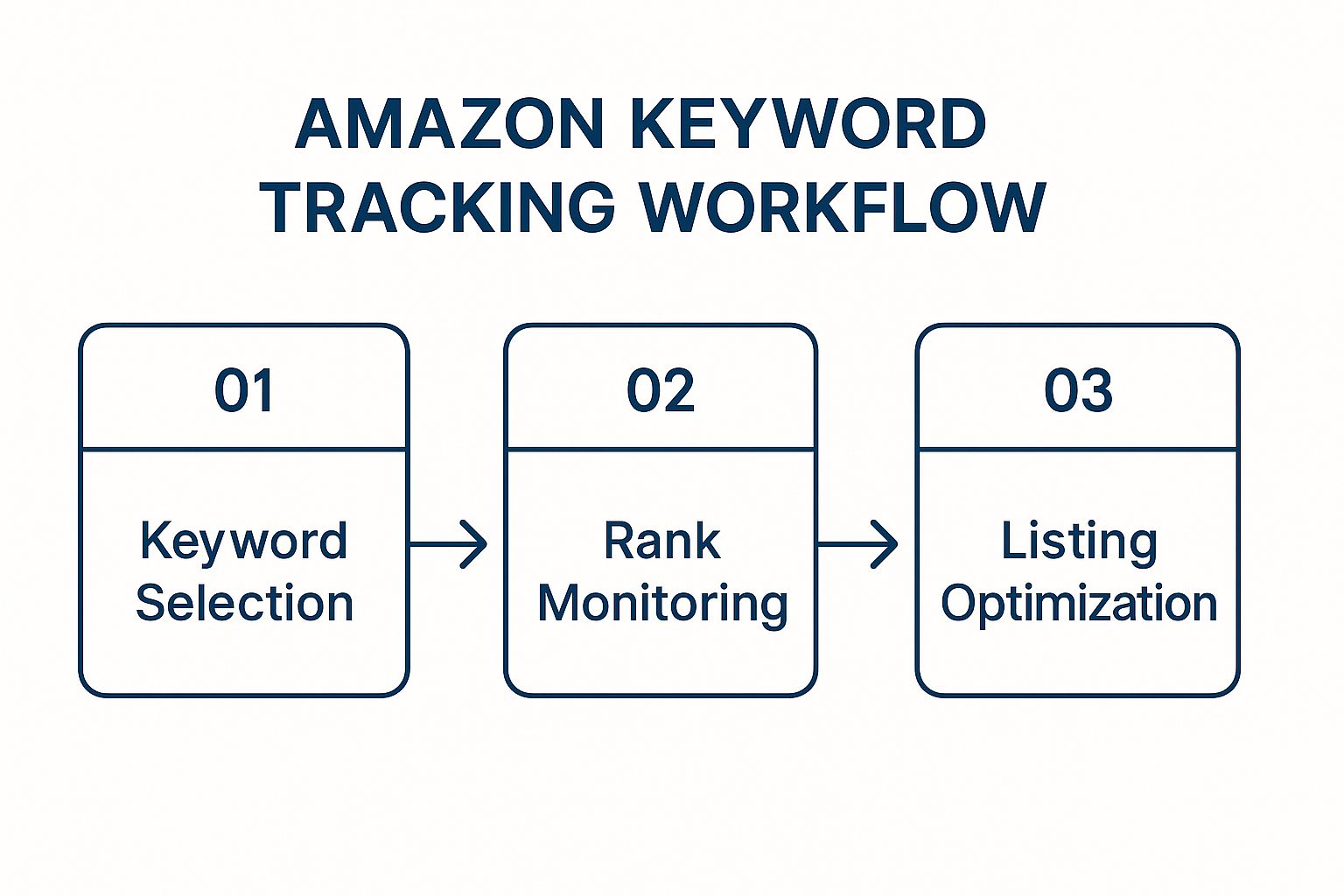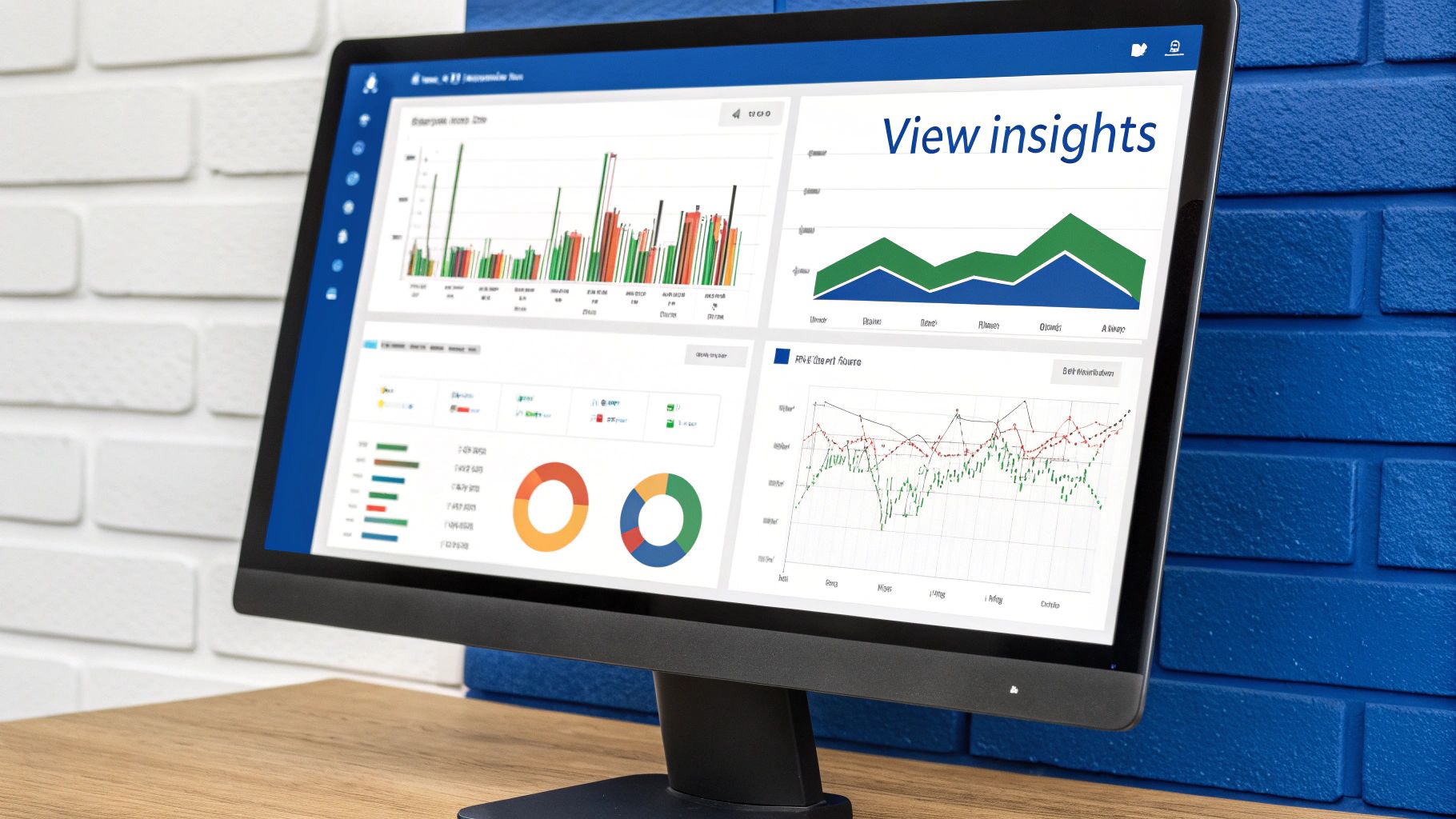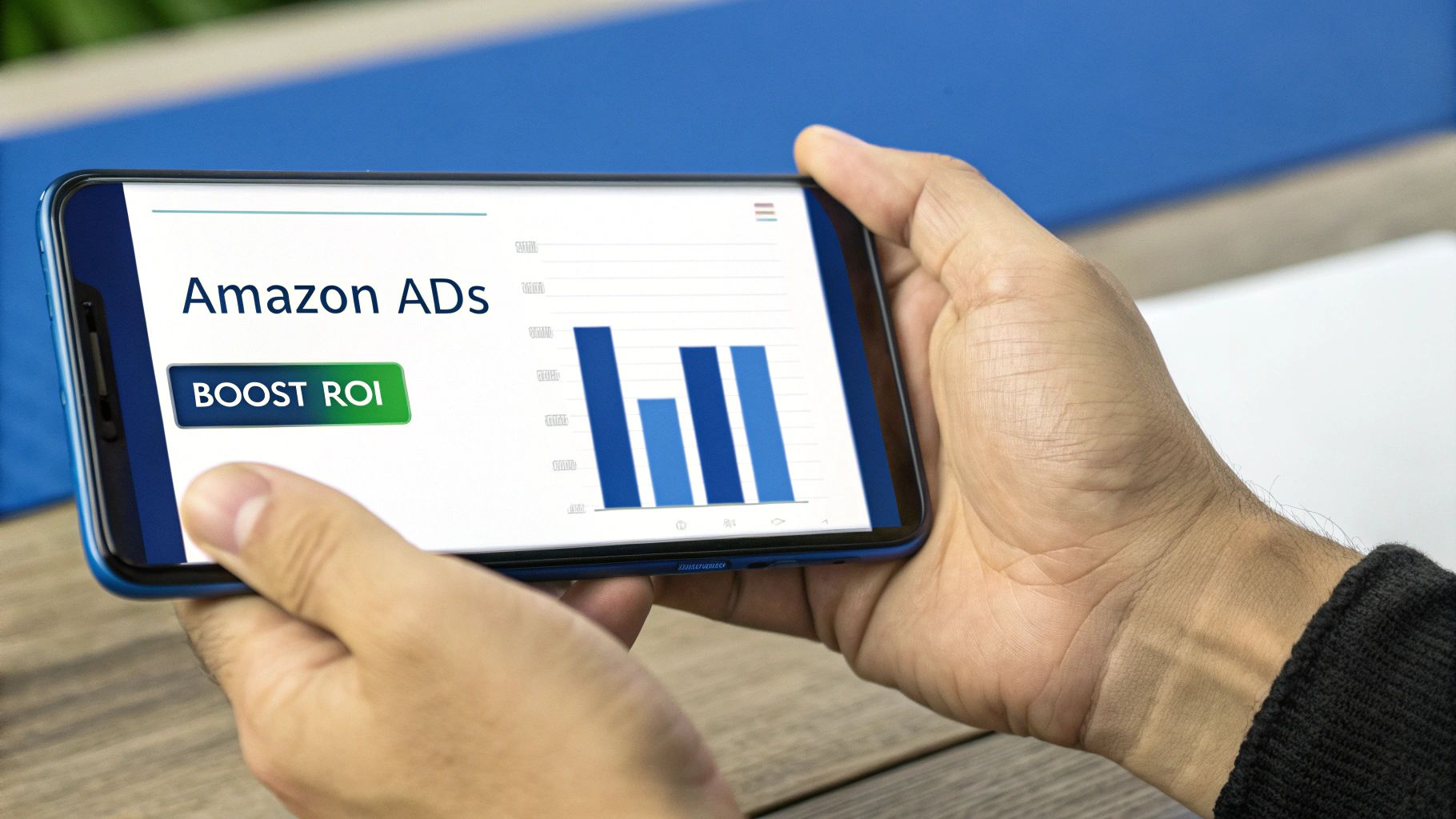Amazon Keyword Tracking: The Blueprint for Profitable Scale
Master Amazon keyword tracking to connect PPC spend with organic rank. This guide provides actionable strategies for eCommerce leaders to drive growth.

What is Amazon keyword tracking? It’s the process of monitoring your product's organic search result position for specific customer queries.
But let's be clear: this isn't a vanity metric. It's the central nervous system of your Amazon strategy—the feedback loop connecting ad spend, listing optimization, and sales velocity to your visibility on the digital shelf. For e-commerce leaders, mastering this isn't optional; it's the difference between guessing and executing a data-driven growth plan.
Why Keyword Tracking is Your Performance Lever

Too many brands treat keyword rank tracking as a passive report card. This is a massive strategic blind spot. Real growth occurs when you stop viewing keyword data as a score and start using it as the primary lever for driving profitable scale. It’s the connective tissue between your PPC campaigns and your organic health.
When executed correctly, keyword tracking creates a powerful flywheel. You launch a targeted PPC campaign, drive sales velocity for a specific keyword, and your tracking tool confirms the direct impact on your organic rank. This is the well-documented principle of Amazon's algorithm in action: paid velocity fuels organic visibility. A brand we worked with in the home goods space saw a 47% improvement in organic rank for their top 10 keywords within 90 days of implementing this PPC-to-organic flywheel strategy. Over time, this virtuous cycle reduces reliance on ad spend and drives down your Total Advertising Cost of Sales (TACoS).
The Strategic Value Beyond Rank Checking
Effective keyword tracking delivers the market intelligence required to make smarter, more profitable decisions across your entire operation. It moves your team from assumption to certainty.
Optimize Ad Spend for Profitability: If you're already ranked #1 organically for "bamboo cutting board," why are you still bidding aggressively to be the top sponsored result? Tracking identifies these inefficiencies, allowing you to reallocate budget from defensive positions to "striking distance" keywords—those on the cusp of page one where a calculated PPC push can deliver exponential returns.
Validate Listing Optimization ROI: You just invested in a complete overhaul of your product title and bullet points. Did it work? Consistent tracking provides the data-backed proof that your SEO efforts are moving the needle. It’s the only way to measure the direct performance impact of your content strategy.
Decode Competitor Strategy: Monitoring competitor keyword rankings is like looking at their playbook. A rival suddenly jumping from position #15 to #4 for a high-value term is a clear signal of an aggressive ad spend. This intelligence allows you to make a strategic decision: defend your position, pivot to a less contested keyword, or ignore the move entirely.
Keyword tracking isn’t about watching numbers on a dashboard. It’s about understanding the cause-and-effect relationship between your actions—ad spend, price changes, content updates—and your market position.
Modern Amazon keyword rank tracking software provides more than simple rank checking. The best platforms layer real-time tracking with historical data and deep competitor insights, which are essential for calibrating both SEO and PPC strategies. They enable you to monitor keywords across different marketplaces, correlate rank changes with events like price drops, and make faster, data-informed decisions. Ultimately, the goal is to align your product with customer search behavior—a fundamental principle that also applies to broader strategies to boost keyword rankings across the digital ecosystem. This mindset is how you transform raw data into a genuine performance driver.
Building a Scalable Keyword Tracking Framework
Tracking every conceivable keyword is a recipe for data overload. Effective Amazon keyword tracking isn’t about volume; it’s about architecting a smart, scalable framework that isolates signals from the noise. Without a system, you're merely observing metrics, not identifying the levers that drive profitable growth.
The objective is to create a repeatable process that directly informs business decisions—from PPC bid management to inventory forecasting. It’s about building a workflow that empowers your team to identify threats, capitalize on opportunities, and execute with speed and precision.
The process is straightforward: select the right keywords, monitor their performance intensely, and use the insights to refine your listings and campaigns.

This cycle is non-negotiable. Insights from monitoring must directly fuel the next round of optimizations, creating a loop of continuous, performance-driven improvement.
Segmenting Keywords for Strategic Focus
The cornerstone of an effective framework is segmentation. Not all keywords hold equal strategic value, so they shouldn't be managed identically. By grouping keywords based on their strategic purpose, you can focus capital and resources where they will generate the greatest return.
We recommend segmenting your keyword portfolio into these four critical categories:
- Core Keywords: These are your high-volume "hero" terms that define the product category (e.g., "air fryer," "yoga mat"). Ranking here drives significant traffic, establishes brand authority, and builds a moat around your market share.
- Conversion Keywords: These are the high-intent, long-tail phrases that signal an imminent purchase (e.g., "stainless steel 8 quart air fryer," "eco friendly non slip yoga mat"). While search volume is lower, their conversion rates are typically much higher, making them crucial for profitability.
- Competitor Keywords: This segment is dedicated to market intelligence. It includes competitor brand names and unique product terms. Tracking these provides insight into their market position and uncovers opportunities for conquesting campaigns.
- Discovery Keywords: This is your R&D lab for growth. It contains emerging, adjacent, or speculative terms you're testing to find untapped search volume and new customer segments before the competition.
This segmented approach transforms tracking from a passive reporting task into an active strategic weapon. It allows you to assign specific KPIs to each keyword bucket, ensuring ad spend and optimization efforts are always aligned with a clear business objective.
To operationalize this, here is a simple framework for strategic segmentation.
Strategic Keyword Segmentation Framework
| Keyword Category | Primary Goal | Key Metrics to Track | Tracking Frequency |
|---|---|---|---|
| Core Keywords | Build brand authority & top-of-funnel traffic | Organic Rank, Share of Voice, Clicks | Daily/Weekly |
| Conversion Keywords | Maximize sales & Return on Ad Spend (ROAS) | Conversion Rate, ACOS, Ad-attributed Sales | Daily |
| Competitor Keywords | Gain market share & competitive insights | Your Rank on Their Terms, Their Rank Changes | Weekly |
| Discovery Keywords | Identify new growth opportunities & niches | Search Volume Trends, Click-Through Rate (CTR) | Bi-weekly/Monthly |
This structured thinking ensures you are proactively managing your entire keyword portfolio, not just reacting to rank fluctuations.
Choosing the Right Tools for Your Workflow
With your framework defined, select a tool that supports it. The best platform isn't the one with the most features; it's the one that integrates seamlessly into your workflow and allows for easy tagging and segmentation.
Flexibility is paramount. Your tool must provide historical rank data, share of voice metrics, and robust competitor tracking. To truly drive performance, learning how to track keyword rankings like a pro is essential for diagnosing what's working and what isn't. The right software makes this efficient, converting raw data into the actionable intelligence needed to power both your PPC and organic growth engines.
Connecting Keyword Data to Profitable PPC

This is where strategy translates into profit. An advanced keyword tracking system is not a standalone organic tool; it is the strategic playbook that should govern your entire advertising operation.
Operating without this connection means you are investing in PPC without understanding its full impact on your organic presence—where long-term, sustainable profitability is built.
The goal is to create a flywheel: paid ads drive sales velocity, which signals relevance to Amazon's A9 algorithm and boosts organic rank. As organic rank improves, you capture more "free" traffic, allowing you to strategically reduce ad spend and lower your Total Advertising Cost of Sale (TACoS). This synergy is the blueprint for scaling an Amazon business profitably.
The Defender vs. Attacker Strategy
Your keyword tracking data enables you to divide your PPC strategy into two core functions: defending existing territory and attacking new opportunities. This framework shifts your ad spend from reactive to proactive.
Consider the keywords where you already hold a top-three organic position. The strategic question is how to manage your bids.
Defend Your Position: If tracking data reveals a competitor is making an aggressive push on one of your core keywords, you must maintain a strong PPC presence. This is a "defensive" spend, protecting your digital shelf space and preventing rivals from siphoning off customers. For top brands, this is a non-negotiable cost of maintaining market leadership.
Scale Back for Profitability: Conversely, for a top-ranked keyword with low competitive pressure and a high organic click-through rate, you can strategically reduce ad spend. This action directly lowers your ACoS for that term, increasing net profit without a significant drop in total sales.
This decision is not based on gut instinct. The choice to defend or scale back is a calculated move, driven by real-time rank data and competitive analysis. This is how you optimize for profit, not just revenue.
Targeting "Striking Distance" Keywords
Your most significant growth opportunities are often your "striking distance" keywords—terms where your product is ranking organically on positions 5 through 15. These are your primary targets for a focused PPC assault.
Why this segment? Because 70% of Amazon shoppers never click past the first page of results. A product on page two is effectively invisible. However, Amazon’s algorithm already recognizes your product's relevance for these terms; it just needs an additional signal.
This is where you switch to "attacker" mode. By launching precise Sponsored Products campaigns targeting only these striking distance keywords, you generate the sales velocity required to break onto page one. This tactic is highly efficient because you're amplifying existing relevance rather than building it from scratch.
For brands serious about accelerating this flywheel, a sophisticated Amazon PPC marketing strategy transforms these data points into tangible profit. It becomes a continuous cycle: track keywords, identify striking distance opportunities, apply targeted ad spend, and monitor the resulting climb in organic rank. This is how you evolve PPC from a sales tool into a powerful engine for long-term organic growth.
Leveraging Historical Data for Predictive Insights
Most brands use keyword tracking to understand the present. That's reactive. Market leaders use it to predict the future. This is how a simple tracking tool becomes a powerful forecasting engine.
By analyzing search volume patterns over multiple years, you can uncover the hidden rhythm of your market. Beyond obvious seasonal spikes, you can identify subtle micro-trends that competitors are missing. This data is invaluable for inventory planning, enabling you to build stock ahead of demand surges and avoid costly overstock situations for declining terms.
Using Keyword Trends to Forecast Demand
Think of historical keyword data as a marketing calendar built by your customers. Once you know when they start searching, you can align your entire go-to-market strategy, from PPC campaigns to A+ Content refreshes.
This is a game-changer for seasonal categories. Data from tools like Helium 10 consistently shows predictable demand curves. A search term like "patio furniture" might see a 300% increase in search volume from February to May. A brand that sees this coming can ramp up ad spend in March, just as consideration begins, capturing customers early in their buying journey. You can see a great breakdown of how to use these seasonal insights on YouTube.
By looking backward, you can see forward. Historical keyword data allows you to map customer demand with confidence, turning seasonality from a chaotic scramble into a predictable, profitable opportunity.
This forward-looking approach ensures your ad spend is deployed at moments of maximum impact. It dictates when to update your storefront for Mother's Day or launch a holiday-themed campaign. To get more granular with ad spend optimization, our guide on lookback windows in Amazon Ads is an excellent resource.
Syncing Operations with Market Rhythm
The insights from historical Amazon keyword tracking must be shared beyond the marketing department. This is mission-critical data for supply chain and operations teams.
Here’s the operational connection:
- Smarter Inventory Planning: Historical data shows a keyword's search volume tripled last October. That means inventory for that product should be ordered in July or August to ensure you're in stock to meet the demand.
- Strategic Product Launches: Launching a new product? Don't do it in a vacuum. Time the launch to coincide with the seasonal upswing of its primary keywords to ride the existing wave of consumer interest.
- Intelligent Budget Allocation: Allocate a greater portion of your PPC budget to the months when historical data confirms peak search and purchase intent.
When you integrate market data this way, you’re not just running ads; you’re building a more intelligent, resilient business where marketing directly informs operational planning.
Advanced Competitor Keyword Analysis

Superior Amazon keyword tracking requires moving beyond monitoring your own ASINs. To dominate a category, you must shift from a defensive to an offensive posture by systematically deconstructing your competitors' strategies.
This is more than basic rank checking. It’s about uncovering the exact keywords that fuel their business and using that intelligence to outmaneuver them. It’s how you stop reacting to the market and start shaping it.
Decoding Competitor PPC Offensives
One of the most valuable signals from competitor tracking is identifying a major PPC push. The data makes it obvious.
Imagine a competitor's organic rank for a core keyword suddenly jumps from position 20 to 8 in one week. This is not organic. It's the result of a significant ad investment to generate sales velocity and manipulate the A9 algorithm.
Observing this allows for a calculated response:
- Defend Your Ground: If this is a high-volume, high-conversion keyword for your brand, it may be necessary to increase your own defensive PPC budget to protect your market share and prevent customer poaching.
- Execute a Strategic Pivot: Alternatively, if the keyword is less critical or the cost-per-click is becoming unsustainable, this is your signal to pivot. Reallocate that ad spend to a less competitive, high-intent long-tail keyword where your budget will have a greater impact on rank.
Without this intelligence, you're left guessing why sales dipped. With it, you're making data-driven decisions based on real-time market dynamics.
By tracking the velocity of a competitor's rank change, you gain an early warning system for their ad strategy. You see exactly where they're investing, giving you the opportunity to counter before they establish a foothold.
Finding Untapped Keyword Opportunities
Identifying a competitor's offensive is powerful, but identifying their blind spots is profitable.
When you map the keyword landscape for your niche, you will inevitably find valuable terms that major competitors are ignoring. These are your "blue ocean" keywords—rich with customer intent but featuring low competition.
For example, your main competitor may rank in the top three for "bamboo cutting board." But your analysis reveals they are absent from page one for the high-intent term "large organic bamboo chopping block."
A focused PPC campaign on this overlooked keyword can often secure a top ranking quickly, allowing you to capture highly qualified buyers your competition doesn't even know exist. A comprehensive competitor analysis framework can help you systematically identify these strategic gaps.
This isn’t about chasing obscure keywords. It’s about using data to build a more resilient and diversified keyword portfolio that insulates you from costly bidding wars and creates a more sustainable path to growth.
Your Top Keyword Tracking Questions Answered
Even for seasoned leaders, the tactical details of keyword tracking can be challenging. Here are no-nonsense answers to the most common questions from brands focused on smart growth.
How Often Should I Check Keyword Ranks?
For your core, high-volume keywords that drive the majority of your revenue, you need to check them daily. The Amazon SERP is volatile; a competitor can launch an aggressive campaign and displace you overnight. Identifying such a threat within 24 hours is critical for mounting an effective defense.
For secondary keywords, such as competitor brand terms or discovery keywords, a weekly or bi-weekly check-in is sufficient. This provides a strategic overview without creating unnecessary noise.
How Do I Measure the ROI of Keyword Tracking?
The definitive KPI for your keyword tracking and optimization efforts is Total Advertising Cost of Sale (TACoS). As your organic rank for a given keyword strengthens and stabilizes in a top position, you can strategically reduce your PPC spend on that same term. This action directly improves profitability by lowering advertising costs without sacrificing sales volume.
The objective isn't just to rank higher. It's to rank higher to spend less on ads for the same or better results. A consistently decreasing TACoS is the clearest indicator that your organic and paid strategies are creating a profitable flywheel.
Which Keyword Tracking Tools Are Worth the Investment?
The best tool is the one that integrates into your team's workflow and provides actionable data, not just dashboards. When evaluating platforms, prioritize these non-negotiable features:
- Historical Rank Data: You must be able to analyze performance over time to identify seasonal trends and the long-term impact of your strategy.
- Competitor Tracking: The ability to monitor competitors' rank changes in near real-time is a significant competitive advantage.
- Keyword Segmentation: The tool must allow you to group keywords into strategic buckets (Core, Conversion, Competitor, etc.) for focused analysis.
Many leading tools also offer browser extensions that provide real-time Amazon search volume data directly on the Amazon site, dramatically accelerating your research process. The right software should save hundreds of hours and lead to sharper, data-driven decisions that directly impact your bottom line.
At Headline Marketing Agency, we don't just track data—we translate it into a performance strategy. We move beyond basic rank checking to engineer a profitable flywheel between your PPC and organic efforts, ensuring every ad dollar is an investment in long-term, sustainable growth.
Discover how our data-driven approach can dominate your category on headlinema.com
Ready to Transform Your Amazon PPC Performance?
Get a comprehensive audit of your Amazon PPC campaigns and discover untapped growth opportunities.